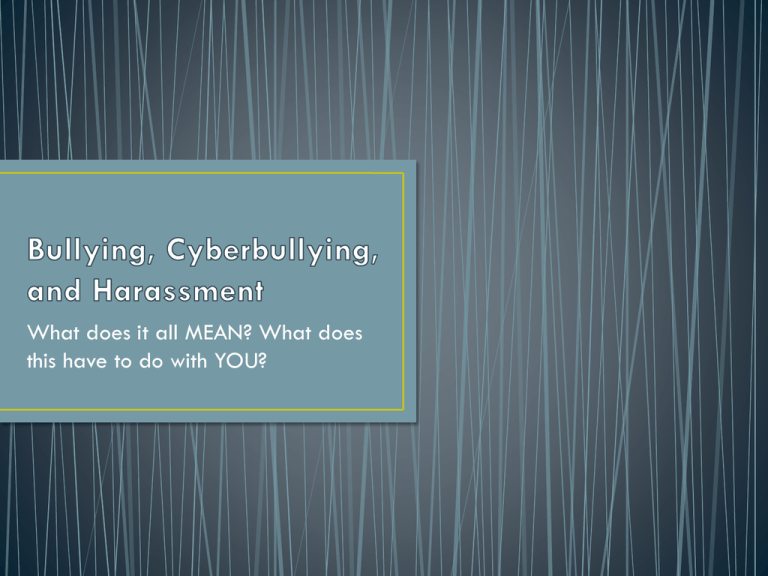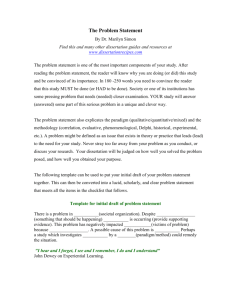
What does it all MEAN? What does
this have to do with YOU?
• With your partner or group, come up with a definition of
BULLYING. Also come up with a definition of HARASSMENT.
• Are these definitions the same or different? Explain the
similarities and differences.
• New York Anti-Bullying Laws & Policies | StopBullying.gov
• There are 3 forms of bullying:
• VERBAL BULLYING – saying or writing mean things.
•
•
•
•
•
Teasing
Name-calling
Inappropriate sexual comments
Taunting
Threatening to cause harm
• SOCIAL BULLYING – also known as relational bullying. Involves
hurting someone’s reputation or relationships. Social bullying
includes:
•
•
•
•
Leaving someone out on purpose
Telling other children not to be friends with someone
Spreading rumors about someone
Embarrassing someone in public
• PHYSICAL BULLYING – hurting a person’s body or possessions.
•
•
•
•
•
Hitting/kicking/pinching
Spitting
Tripping/pushing
Taking or breaking someone’s things
Making mean or rude hand gestures
• Cyberbullying – Intentional and repeated harm inflicted
through the use of computers, cell phones, and other electronic
devices.
• Cyberbullicide - “suicide indirectly or directly influenced by
experiences with online aggression.” (Hinduja & Patchin, 2009)
• Megan Meier Story – YouTube
• Phoebe Prince, 15 May Have Committed Suicide Because of
Cyber Bullying - YouTube
• My story: Struggling, bullying, suicide, self harm – YouTube
• With your partner or group, discuss what you have witnessed
here at NPHS. Come up with a list of ways you have witnessed
bullying or cyberbullying that directly relates to a student or
group of students targeted from this school.
• Be ready to discuss with the class.
• ANYONE can be affected.
• Anyone who is targeted as being “different” or “weird”
• Are perceived as different from their peers, such as being overweight or
underweight, wearing glasses or different clothing, being new to a school, or
being unable to afford what kids consider “cool”
• Are perceived as weak or unable to defend themselves (passive)
• Are depressed, anxious, or have low self esteem
• Are less popular than others and have few friends
• Do not get along well with others, seen as annoying or provoking, or
antagonize others for attention
• Families
• Whole Communities
• Schools
• With your partner or group, reflect and discuss the different
forms of bullying that you have experienced, witnessed, or just
heard about in class.
• Come up with 2 realistic scenarios involving bullying. Create one
that involves cyberbullying and one that involves verbal, social,
or physical bullying.
• Write your scenarios down on a separate sheet of paper.
• 15,425 usable questionnaires from 50 States and 158
schools around the country; grades 9 - 12
CDC-Youth Online-High School YRBS: Home Page
• Nationwide, 16.2% of students had been electronically
bullied, including being bullied through e-mail, chat
rooms, instant messaging, websites, or texting, during
the 12 months before the survey (Table 16). Overall, the
prevalence of having been electronically bullied was
higher among female (22.1%) than male (10.8%)
students
• Nationwide, 20.1% of students had been bullied on
school property during the 12 months before the survey
• During the 12 months before the survey, 28.5% of
students nationwide had felt so sad or hopeless almost
every day for 2 or more weeks in a row that they stopped
doing some usual activities
• Nationwide, 15.8% of students had seriously considered
attempting suicide during the 12 months before the
survey
• During the 12 months before the survey, 12.8% of
students nationwide had made a plan about how they
would attempt suicide
• Nationwide, 7.8% of students had attempted suicide one
or more times during the 12 months before the survey
• With your partner or group, create an idea for an anti-bullying
campaign, activity, or workshop/seminar.
• Within your plan, you should include the following:
• 1. Who is advising/running/directing the campaign, activity or workshop.
• 2. The main goals (at least three) directly related to NPHS needs.
• 3. A list of the main bullying behaviors to be addressed.
• 4. A plan of activities/events (minimum of two):
•
- List each activity/event and include:
•
a. What type (what is it (description)?
•
b. Who is it aimed to help?
•
c. How it can be organized (what is/who will be involved).
•
d. Overall goal of each event/activity.
• 5. Be prepared to share your ideas with the class.







